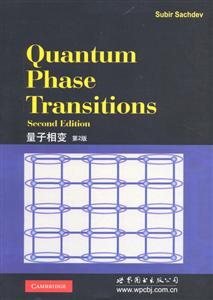扫一扫
关注中图网
官方微博
本类五星书更多>
-
>
宇宙、量子和人类心灵
-
>
考研数学专题练1200题
-
>
希格斯:“上帝粒子”的发明与发现
-
>
神农架叠层石:10多亿年前远古海洋微生物建造的大堡礁
-
>
二十四史天文志校注(上中下)
-
>
声音简史
-
>
浪漫地理学:追寻崇高景观
买过本商品的人还买了
量子相变-第2版 版权信息
- ISBN:9787510084478
- 条形码:9787510084478 ; 978-7-5100-8447-8
- 装帧:一般胶版纸
- 册数:暂无
- 重量:暂无
- 所属分类:>>
量子相变-第2版 内容简介
《量子相变(第2版)(英文版)》讲述量子相变是物质的量子相在零温下的一种相变。相比于经典相变,量子相变可以仅通过在绝对零度下改变一些物理参数(如磁场或压力)就可以实现。量子相变描述量子涨落导致的多体系统基态的突变,这可以是一个二级相变。在相变现象中,大量微观粒子的相互作用与热或量子涨落的竞争起到核心的作用,而相变的行为通常具有普适性,又与相互作用的细节无关。
量子相变-第2版 目录
From the Preface to the first edition page xiii
Preface to the second edition xvii
Part I Introduction
1 Basic concepts
1.1 What is a quantum phase transition?
1.2 Nonzero temperature transitions and crossovers
1.3 Experimental examples
1.4 Theoretical models
1.4.1 Quantum Ising model
1.4.2 Quantum rotor model l
1.4.3 Physical realizations of quantum rotors
2 Overview
2.1 Quantum field theories
2.2 What's different about quantum transitions?
Part II A first course
3 Classical phase transitions
3.1 Mean-field theory
3.2 Landau theory
3.3 Fluctuations and perturbation theory
3.3.1 Gaussian integrals
3.3.2 Expansion for susceptibility
Exercises
4 The renormalization group
4.1 Gaussian theory
4.2 Momentum shell RG
4.3 Field renormalization
4.4 Correlation functions
Exercises
5 The quantum Ising model
5.1 Effective Hamiltonian method
5.2 Large-g expansion
5.2.1 One.particle states
5.2.2 TwO-particle states
5.3 Small-g expansion
5.3.1 d=
5.3.2 d=
5.4 Review
5.5 The classical Ising chain
5.5.1 The scaling limit
5.5.2 Universality
5.5.3 Mapping to a quantum model:Ising spin in a transverse field
5.6 Mapping of the quantum Ising chain to a classical Ising model Exercises
6 The quantum rotor modeI
6.1 Large-g expansion
6.2 Small-g expansion
6.3 The classical X Y chain and an O(2)quantum rotor
6.4 The classical Heisenberg chain and an O(3)quantum rotor
6.5 Mapping to classical field theories
6.6 Spectrum of quantum field theory
6.6.1 Paramagnet
6.6.2 Quantum critical point
6.6.3 Magnetic order
Exercises
7 Correlations,susceptibilities,and the quantum critical point
7.1 Spectral representation
7.1.1 Structure factor
7.1.2 Linear response
7.2 Correlations across the quantum critical point
7.2.1 Paramagnet
7.2.2 Quantum critical point
7.2.3 Magnetic order
Exercises
8 Broken symmetries
8.1 Discrete symmetry and surface tension
8.2 Continuous symmetry and the helicity modulus
8.2.1 0rder parameter correlations
8.3 The London equation and the superfluid density
8.3.1 The rotor model
Exercises
9 Boson Hubbard modeI
9.1 Mean-field theory
9.2 Coherent state path integral
9.2.1 Boson coherent states
9.3 Continuum quantum field theories
Exercises
Part ⅢNonzero temperatures
10 The Ising chain in a transverse field
10.1 Exact spectrum
10.2 Continuum theory and scaling transformations
10.3 Equal-time correlations of the order parameter
10.4 Finite temperature crossovers
10.4.1 Low T on the magnetically ordered side,△>0,T《△
10.4.2 Low T on the quantum paramagnetic side,△<0,T《「△」
10.4.3 Continuum high T,T》「△」
10.4.4 Summary
11 Quantum rotor models:large-N Iimit
11.1 Continuum theory and large-N limit
11.2 Zero temperature
11.2.1 Quantum paramagnet,g>gc
11.2.2 Critical point,g=gc
11.2.3 Magnetically ordered ground state,g<gc
11.3 Nonzero temperatures
11.3.1 Low T on the quantum paramagnetic side,g>gc,T《△+
11.3.2 High T,T》△+,△-
11.3.3 Low T on the magnetically ordered side,g<gf,T《△-
11.4 Numerical studies
12 Thed=1,0(N≥3)rotormodels
12.1 Scaling analysis at zero temperature
12.2 Low-temperature limit of the continuum theory,T《△+
……
Part Ⅳ Other models
Preface to the second edition xvii
Part I Introduction
1 Basic concepts
1.1 What is a quantum phase transition?
1.2 Nonzero temperature transitions and crossovers
1.3 Experimental examples
1.4 Theoretical models
1.4.1 Quantum Ising model
1.4.2 Quantum rotor model l
1.4.3 Physical realizations of quantum rotors
2 Overview
2.1 Quantum field theories
2.2 What's different about quantum transitions?
Part II A first course
3 Classical phase transitions
3.1 Mean-field theory
3.2 Landau theory
3.3 Fluctuations and perturbation theory
3.3.1 Gaussian integrals
3.3.2 Expansion for susceptibility
Exercises
4 The renormalization group
4.1 Gaussian theory
4.2 Momentum shell RG
4.3 Field renormalization
4.4 Correlation functions
Exercises
5 The quantum Ising model
5.1 Effective Hamiltonian method
5.2 Large-g expansion
5.2.1 One.particle states
5.2.2 TwO-particle states
5.3 Small-g expansion
5.3.1 d=
5.3.2 d=
5.4 Review
5.5 The classical Ising chain
5.5.1 The scaling limit
5.5.2 Universality
5.5.3 Mapping to a quantum model:Ising spin in a transverse field
5.6 Mapping of the quantum Ising chain to a classical Ising model Exercises
6 The quantum rotor modeI
6.1 Large-g expansion
6.2 Small-g expansion
6.3 The classical X Y chain and an O(2)quantum rotor
6.4 The classical Heisenberg chain and an O(3)quantum rotor
6.5 Mapping to classical field theories
6.6 Spectrum of quantum field theory
6.6.1 Paramagnet
6.6.2 Quantum critical point
6.6.3 Magnetic order
Exercises
7 Correlations,susceptibilities,and the quantum critical point
7.1 Spectral representation
7.1.1 Structure factor
7.1.2 Linear response
7.2 Correlations across the quantum critical point
7.2.1 Paramagnet
7.2.2 Quantum critical point
7.2.3 Magnetic order
Exercises
8 Broken symmetries
8.1 Discrete symmetry and surface tension
8.2 Continuous symmetry and the helicity modulus
8.2.1 0rder parameter correlations
8.3 The London equation and the superfluid density
8.3.1 The rotor model
Exercises
9 Boson Hubbard modeI
9.1 Mean-field theory
9.2 Coherent state path integral
9.2.1 Boson coherent states
9.3 Continuum quantum field theories
Exercises
Part ⅢNonzero temperatures
10 The Ising chain in a transverse field
10.1 Exact spectrum
10.2 Continuum theory and scaling transformations
10.3 Equal-time correlations of the order parameter
10.4 Finite temperature crossovers
10.4.1 Low T on the magnetically ordered side,△>0,T《△
10.4.2 Low T on the quantum paramagnetic side,△<0,T《「△」
10.4.3 Continuum high T,T》「△」
10.4.4 Summary
11 Quantum rotor models:large-N Iimit
11.1 Continuum theory and large-N limit
11.2 Zero temperature
11.2.1 Quantum paramagnet,g>gc
11.2.2 Critical point,g=gc
11.2.3 Magnetically ordered ground state,g<gc
11.3 Nonzero temperatures
11.3.1 Low T on the quantum paramagnetic side,g>gc,T《△+
11.3.2 High T,T》△+,△-
11.3.3 Low T on the magnetically ordered side,g<gf,T《△-
11.4 Numerical studies
12 Thed=1,0(N≥3)rotormodels
12.1 Scaling analysis at zero temperature
12.2 Low-temperature limit of the continuum theory,T《△+
……
Part Ⅳ Other models
展开全部
量子相变-第2版 作者简介
Subir Sachdev(S. 萨奇德夫, 美国)是国际知名学者,在数学和物理学界享有盛誉。本书凝聚了作者多年科研和教学成果,适用于科研工作者、高校教师和研究生。
书友推荐
本类畅销
-
物理学之美-插图珍藏版
¥27.6¥69 -
为了人人晓得相对论
¥6.9¥13.5 -
世纪幽灵-走近量子纠缠
¥12¥28 -
量子宇宙:一切可能发生的正在发生
¥16.1¥32.8 -
数学物理方程
¥12.9¥26 -
物理学家说文析理
¥20¥50




















